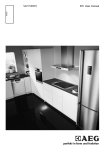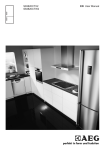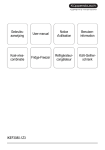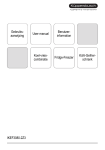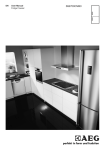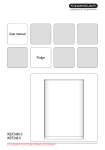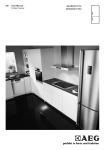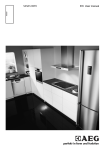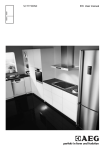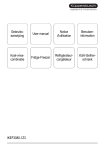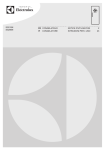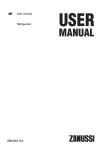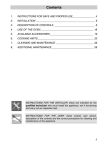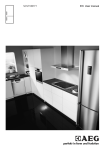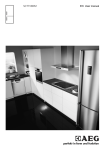Download SKZ81800C0 - Amazon Web Services
Transcript
EN User Manual Refrigerator SKZ81800C0 2 www.aeg.com CONTENTS 1. SAFETY INFORMATION.................................................................................................3 2. SAFETY INSTRUCTIONS................................................................................................ 4 3. OPERATION.................................................................................................................... 5 4. DAILY USE........................................................................................................................7 5. HINTS AND TIPS........................................................................................................... 11 6. CARE AND CLEANING................................................................................................ 11 7. TROUBLESHOOTING...................................................................................................12 8. INSTALLATION............................................................................................................. 15 9. NOISES...........................................................................................................................16 10. TECHNICAL INFORMATION.....................................................................................17 FOR PERFECT RESULTS Thank you for choosing this AEG product. We have created it to give you impeccable performance for many years, with innovative technologies that help make life simpler features you might not find on ordinary appliances. Please spend a few minutes reading to get the very best from it. Visit our website for: Get usage advice, brochures, trouble shooter, service information: www.aeg.com Register your product for better service: www.registeraeg.com Buy Accessories, Consumables and Original spare parts for your appliance: www.aeg.com/shop CUSTOMER CARE AND SERVICE Always use original spare parts. When contacting our Authorised Service Centre, ensure that you have the following data available: Model, PNC, Serial Number. The information can be found on the rating plate. Warning / Caution-Safety information General information and tips Environmental information Subject to change without notice. ENGLISH 1. 3 SAFETY INFORMATION Before the installation and use of the appliance, carefully read the supplied instructions. The manufacturer is not responsible if an incorrect installation and use causes injuries and damages. Always keep the instructions with the appliance for future reference. 1.1 Children and vulnerable people safety • • • • This appliance can be used by children aged from 8 years and above and persons with reduced physical, sensory or mental capabilities or lack of experience and knowledge if they have been given supervision or instruction concerning use of the appliance in a safe way and understand the hazards involved. Do not let children play with the appliance. Cleaning and user maintenance shall not be made by children without supervision. Keep all packaging away from children. 1.2 General Safety • • • • • This appliance is intended to be used in household and similar applications such as: – Farm houses; staff kitchen areas in shops, offices and other working environments – By clients in hotels, motels, bed and breakfast and other residential type environments Keep ventilation openings, in the appliance enclosure or in the built-in structure, clear of obstruction. Do not use mechanical devices or other means to accelerate the defrosting process, other than those recommended by the manufacturer. Do not damage the refrigerant circuit. Do not use electrical appliances inside the food storage compartments of the appliance, unless they are of the type recommended by the manufacturer. 4 www.aeg.com • • • • Do not use water spray and steam to clean the appliance. Clean the appliance with a moist soft cloth. Only use neutral detergents. Do not use abrasive products, abrasive cleaning pads, solvents or metal objects. Do not store explosive substances such as aerosol cans with a flammable propellant in this appliance. If the supply cord is damaged, it must be replaced by the manufacturer, its Authorised Service Centre or similarly qualified persons in order to avoid a hazard. 2. SAFETY INSTRUCTIONS 2.1 Installation WARNING! Only a qualified person must install this appliance. • Remove all the packaging. • Do not install or use a damaged appliance. • Obey the installation instruction supplied with the appliance. • Always be careful when you move the appliance because it is heavy. Always wear safety gloves. • Make sure the air can circulate around the appliance. • Wait at least 4 hours before connecting the appliance to the power supply. This is to allow the oil to flow back in the compressor. • Do not install the appliance close to radiators or cookers, oven or hobs. • The rear of the appliance must stand against the wall. • Do not install the appliance where there is direct sunlight. • Do not install this appliance in areas that are too humid or too colds, such as the construction appendices, garages or wine cellars. • When you move the appliance, lift it by the front edge to avoid scratching the floor. 2.2 Electrical connection WARNING! Risk of fire and electrical shock. • The appliance must be earthed. • Make sure that the electrical information on the rating plate agrees with the power supply. If not, contact an electrician. • Always use a correctly installed shockproof socket. • Do not use multi-plug adapters and extension cables. • Make sure not to cause damage to the electrical components (e.g. mains plug, mains cable, compressor). Contact the Authorised Service Centre or an electrician to change the electrical components. • The mains cable must stay below the level of the mains plug. • Connect the mains plug to the mains socket only at the end of the installation. Make sure that there is access to the mains plug after the installation. • Do not pull the mains cable to disconnect the appliance. Always pull the mains plug. 2.3 Use WARNING! Risk of injury, burns, electrical shock or fire. ENGLISH • Do not change the specification of this appliance. • Do not put electrical appliances (e.g. ice cream makers) in the appliance unless they are stated applicable by the manufacturer. • Be careful not to cause damage to the refrigerant circuit. It contains isobutane (R600a), a natural gas with a high level of environmental compatibility. This gas is flammable. • If damage occurs to the refrigerant circuit, make sure that there are no flames and sources of ignition in the room. Ventilate the room. • Do not let hot items to touch the plastic parts of the appliance. • Do not store flammable gas and liquid in the appliance. • Do not put flammable products or items that are wet with flammable products in, near or on the appliance. • Do not touch the compressor or the condenser. They are hot. 2.4 Care and cleaning WARNING! Risk of injury or damage to the appliance. • Before maintenance, deactivate the appliance and disconnect the mains plug from the mains socket. • This appliance contains hydrocarbons in the cooling unit. Only a qualified person must do the maintenance and the recharging of the unit. • Regularly examine the drain of the appliance and if necessary, clean it. If the drain is blocked, defrosted water collects in the bottom of the appliance. 2.5 Disposal WARNING! Risk of injury or suffocation. • Disconnect the appliance from the mains supply. • Cut off the mains cable and discard it. • Remove the door to prevent children and pets to be closed inside of the appliance. • The refrigerant circuit and the insulation materials of this appliance are ozone-friendly. • The insulation foam contains flammable gas. Contact your municipal authority for information on how to discard the appliance correctly. • Do not cause damage to the part of the cooling unit that is near the heat exchanger. 3. OPERATION 3.1 Control panel 1 6 1 2 3 4 Display Temperature warmer button Temperature colder button OK 5 5 4 3 5 Mode 6 ON/OFF 2 6 www.aeg.com It is possible to change predefined sound of buttons by pressing together Mode and Temperature colder button for some seconds. Change is reversible. Display A B C D G F E A) B) C) D) Timer function COOLMATIC function Longfresh indicator Temperature indicator 3.2 Switching on 1. Connect the mains plug to the power socket. 2. Press ON/OFF if the display is off. If DEMO appears on the display, the appliance is in demonstration mode. Refer to "What to do if...". The temperature indicator show the set default temperature. To select a different set temperature refer to "Temperature regulation". 3.3 Switching off Press the appliance ON/OFF for 5 seconds. The display switches off. To disconnect the appliance from the power, disconnect the mains plug from the power socket. 3.4 Temperature regulation The default set temperature for the fridge is +5°C. Set the temperature of the fridge by pressing the temperature button. The temperature indicator shows the set temperature. E) Alarm indicator F) ChildLock function G) MinuteMinder function The set temperature will be reached within 24 hours. After a power failure the set temperature remains stored. 3.5 MinuteMinder function The MinuteMinder function is to be used to set an acoustic alarm at the preferred time, useful for example when a recipe requires to cool down food products for a certain length of time. 1. Press Mode until the corresponding icon appears. The MinuteMinder indicator flashes. The Timer shows the set value (30 minutes) for a few seconds. 2. Press the Temperature colder or Temperature warmer button to change the Timer set value from 1 to 90 minutes. 3. Press OK to confirm. The MinuteMinder indicator is shown. The Timer starts to flash (min). It is possible to change the time at any time during the countdown and at the end by pressing the Temperature colder button and the Temperature warmer button. At the end of the countdown, the MinuteMinder indicator flashes and an audible alarm sounds. Press OK to switch off the sound and terminate the function. It is possible to deactivate the function at any time during the countdown by ENGLISH 7 repeating the function steps, until the indicator turns off. 3.8 Longfresh compartment setting 3.6 ChildLock function 1. Press Mode until the corresponding icon appears. ‘3’ should be displayed on the setting indicator. This is the default setting that ensures the most effective performance. To adjust the temperature select the preferable setting 1– 5 (1 being the coldest, 5 the warmest). 2. Press the temperature buttons on the control panel to reach the desired setting. 3. Press OK to confirm. The indicator returns to the fridge temperature setting in a few seconds. Activate the ChildLock function to lock the buttons from unintentional operation. 1. Press Mode until the corresponding icon appears. The ChildLock indicator flashes. 2. Press OK to confirm. The ChildLock indicator is shown. To deactivate the ChildLock function, repeat the procedure until the ChildLock indicator goes off. 3.7 COOLMATIC function If you need to insert a large amount of warm food, for example after doing grocery shopping, we suggest activating the COOLMATIC function to chill the products more rapidly and to avoid warming the other food which is already in the refrigerator. 1. Press Mode until the corresponding icon appears. The COOLMATIC indicator flashes. 2. Press OK to confirm. The COOLMATIC indicator is shown. 3.9 Door open alarm An acoustic alarm will sound if the door is left open for a few minutes. The door open alarm conditions are indicated by: • a flashing alarm indicator; • an acoustic buzzer. When normal conditions are restored (door closed), the alarm will stop. During the alarm phase, the buzzer can be switched off by pressing any control panel button. The COOLMATIC function shuts off automatically after 6 hours. To switch off the function before its automatic end, repeat the steps until the COOLMATIC indicator goes off or select a different fridge set temperature. 4. DAILY USE 4.1 Cleaning the interior 4.2 Movable shelves Before using the appliance for the first time, wash the interior and all internal accessories with lukewarm water and some neutral soap so as to remove the typical smell of a brand-new product, then dry thoroughly. The walls of the refrigerator are equipped with a series of supports so that the shelves can be positioned as desired. Do not use detergents or abrasive powders, as these will damage the finish. For better use of space, the front halfshelves (A) can be placed under the rear ones. (B) 8 www.aeg.com 4.4 Longfresh compartment A B 4.3 Positioning the door shelves The storage temperature and the relative humidity (between 45 and 90 %) provide optimal conditions for the storage of various kinds of food. To learn about the temperature settings in the Longfresh compartment please refer to the “Longfresh compartment setting” section Longfreshcompartment is suitable for the storage of a variety of fresh food as it preserves its high nutritional values as well as high humidity level much longer in comparison to the regular refrigerator. The Longfresh compartment is also suitable for defrosting food. To permit storage of food packages of various sizes, the door shelves can be placed at different heights. The thawed food can be stored up to two days. To make these adjustments proceed as follows: 4.5 Humidity control 1. Gradually pull the shelf in the direction of the arrows until it comes free. Both bottom drawers can be used according to the desired storage conditions, independently of each other, with lower or higher humidity. Each drawer has a separate humidity setting regulated by the slide valve at the front of the drawer. The third (top) drawer has only a dry setting, thus no possibility to regulate humidity control. • “Dry“: low air humidity - up to 50 % relative humidity This humidity level is reached when both sliders are set into this position 2. Reposition the shelf as required. The model is equipped with a variable storage box which is fitted under a door shelf compartment and can be slide sideways. and the ventilation openings are wide open. • Humid“: high air humidity - up to 90% This humidity level is reached when both sliders are set in this position and the ventilation openings are ENGLISH closed. The desired humidity is kept inside the drawer. 4.6 Drawer The compartment has stops to prevent the drawers from falling out when fully extended. 4.7 Fresh food storage time in the LongFresh compartment Type of food Air humidity adjustment Storage time Onion "dry” up to 5 months Butter “dry” up to 1 month Large pork cuts “dry” up to 10 days Beef, venison, small pork cuts, poultry “dry” up to 7 days Tomato sauce “dry” up to 4 days Fish, shellfish, cooked meat products “dry” up to 3 days Cooked seafood “dry” up to 2 days “humid” up to 1 month Artichokes, cauliflower, chicory, iceberg lettuce, endive, lamb’s lettuce, lettuce, leeks, radicchio “humid” up to 21 days Broccoli, Chinese leaves, kale, cabbage, radishes, Savoy cabbage “humid” up to 14 days Peas, kohlrabi “humid” up to 10 days Spring onions, radishes, asparagus, spinach “humid” up to 7 days Salad, vegetables Carrots, herbs, Brussels sprouts, celery 9 10 www.aeg.com Type of food Fruit Pears, dates (fresh), strawberries, peaches Air humidity adjustment Storage time “humid” up to 1 month Plums rhubarb, gooseberries “humid” up to 21 days Apples (not sensitive to cold), quinces “humid” up to 20 days Apricots, cherries “humid” up to 14 days Damsons, grapes “humid” up to 10 days Blackberries, currants “humid” up to 8 days Figs (fresh) “humid” up to 7 days Blueberries, raspberries “humid” up to 5 days Cakes containing cream and other kinds of pastry products can be stored in the LongFresh compartment for 2 or 3 days. Not to be placed in the LongFresh compartment: • cold sensitive fruit which have to be stored at cellar or room temperature like pineapple, bananas, grapefruit, melons, mango, papaya, oranges, lemons, kiwi fruit. • The types of food not mentioned above should be stored in the refrigerator compartment (e.g. all sorts of cheese, cold cuts, etc.) The level of air humidity in the drawers depends on the content of humidity in the stored food, vegetable and fruit and on the frequency of door opening The LongFresh compartment is also suitable for slow thawing of food. In this case the thawed food can be stored in the LongFresh compartment for up to two days. • Pay attention to the freshness of the food, especially on the expiry date. Quality and freshness influence the storage time. • The whole storage cycle time will depend on the preservation conditions made prior to the final storage in the fridge. • Food, fruit or vegetables should always be packed or wrapped up before storage. • Animal food always store packed and dry. • Food rich in proteins will go bad quicker. This means seafood will spoil before fish which in turn will spoil before meat. While storing food in a LongFresh compartment storage time for that kind of food can be increased by up to three times as well without loss on quality. • All food stored in a LongFresh compartment should be taken out of the drawers roughly 15-30 min before consumption, particularly fruit and vegetables to be consumed without any additional cooking process. Allowing fruit and vegetables to return to room temperature will improve the texture and flavour. ENGLISH 11 5. HINTS AND TIPS 5.1 Normal operating sounds The following sounds are normal during operation: • A faint gurgling and bubbling sound from coils sound when refrigerant is pumped. • A whirring and pulsating sound from the compressor when refrigerant is pumped. • A sudden cracking noise from inside appliance caused by thermic dilatation (a natural and not dangerous physical phenomenon). • A faint click noise from the temperature regulator when the compressor switches on or off. 5.2 Hints for energy saving • Do not open the door frequently or leave it open longer than absolutely necessary. 5.3 Hints for fresh food refrigeration To obtain the best performance: • do not store warm food or evaporating liquids in the refrigerator • do cover or wrap the food, particularly if it has a strong flavour • position food so that air can circulate freely around it 5.4 Hints for refrigeration Useful hints: • Meat (all types) : wrap in polythene bags and place on the glass shelf above the vegetable drawer. • For safety, store in this way only one or two days at the most. • Cooked foods, cold dishes, etc..: these should be covered and may be placed on any shelf. • Fruit and vegetables: these should be thoroughly cleaned and placed in the special drawer(s) provided. • Butter and cheese: these should be placed in special airtight containers or wrapped in aluminium foil or polythene bags to exclude as much air as possible. • Bottles: these need a cap and should be stored on the door bottle shelf, or (if equipped) on the bottle rack. • Bananas, potatoes, onions and garlic, if not packed, must not be kept in the refrigerator. 6. CARE AND CLEANING WARNING! Refer to Safety chapters. 6.1 General warnings CAUTION! Unplug the appliance before carrying out any maintenance operation. This appliance contains hydrocarbons in its cooling unit; maintenance and recharging must therefore only be carried out by authorized technicians. The accessories and parts of the appliance are not suitable for washing in a dishwasher. 6.2 Periodic cleaning CAUTION! Do not pull, move or damage any pipes and/or cables inside the cabinet. CAUTION! Take care of not to damage the cooling system. 12 www.aeg.com CAUTION! When moving the cabinet, lift it by the front edge to avoid scratching the floor. The equipment has to be cleaned regularly: 1. Clean the inside and accessories with lukewarm water and some neutral soap. 2. Regularly check the door seals and wipe clean to ensure they are clean and free from debris. 3. Rinse and dry thoroughly. 4. If accessible, clean the condenser and the compressor at the back of the appliance with a brush. This operation will improve the performance of the appliance and save electricity consumption. The lowest shelf, dividing the cooler compartment from the compartment can be removed only for cleaning. To remove pull out the shelf straight. To make sure fully functionality of the LongFresh compartment the lowest shelf and cover plates must be put back in their original position after cleaning. The cover plates above the drawers in the compartment can be taken out for cleaning. 6.3 Defrosting of the refrigerator Defrosting of the fridge compartment is automatic. The water that forms flows into a recipient on the compressor and evaporates. The recipient cannot be removed. 6.4 Periods of non-operation When the appliance is not in use for long periods, take the following precautions: 1. Disconnect the appliance from electricity supply. 2. Remove all food. 3. Clean the appliance and all accessories. 4. Leave the door/doors open to prevent unpleasant smells. WARNING! If the cabinet will be kept on, ask somebody to check it once in a while to prevent the food inside from spoiling in case of a power failure. 7. TROUBLESHOOTING WARNING! Refer to Safety chapters. 7.1 What to do if... Problem Possible cause Solution The appliance does not operate. The appliance is switched off. Switch on the appliance. The mains plug is not con- Connect the mains plug to the nected to the mains socket mains socket correctly. correctly. There is no voltage in the mains socket. Connect a different electrical appliance to the mains socket. Contact a qualified electrician. ENGLISH Problem Possible cause Solution The appliance is noisy. The appliance is not supported properly. Check if the appliance stands stable. 13 A rectangular symbol is Temperature sensor probshown instead of numbers lem. on the Temperature Display. Contact the nearest Authorised Service Centre (the cooling system will continue to keep food products cold, but temperature adjustment will not be possible). The lamp does not work. The lamp is in stand-by. Close and open the door. The lamp does not work. The lamp is defective. Contact the nearest Authorised Service Centre. The compressor operates continually. Temperature is set incorrectly. Refer to "Operation" chapter. Many food products were put in at the same time. Wait some hours and then check the temperature again. The room temperature is too high. Refer to climate class chart on the rating plate. Food products placed in the appliance were too warm. Allow food products to cool to room temperature before storing. The door is not closed cor- Refer to "Closing the door". rectly. The COOLMATIC function Refer to "COOLMATIC funcis switched on. tion". The compressor does not start immediately after pressing the COOLMATIC, or after changing the temperature. This is normal, no error has The compressor starts after a occurred. period of time. Water flows inside the refrig- The water outlet is clogerator. ged. Food products prevent that water flows into the water collector. Water flows on the floor. Clean the water outlet. Make sure that food products do not touch the rear plate. The melting water outlet is Attach the melting water outnot connected to the let to the evaporative tray. evaporative tray above the compressor. 14 www.aeg.com Problem Possible cause Solution Temperature cannot be set. The FROSTMATIC or COOLMATIC function is switched on. Switch off FROSTMATIC or COOLMATIC manually, or wait until the function resets automatically to set the temperature. Refer to "FROSTMATIC or COOLMATIC function". DEMO appears on the display. The appliance is in demon- Keep the OK pressed for apstration mode. proximately 10 seconds until a long sound is heard and display shuts off for a short time. The temperature in the appliance is too low/too high. The temperature regulator Set a higher/lower temperais not set correctly. ture. The door is not closed cor- Refer to "Closing the door". rectly. The food products' temperature is too high. Let the food products temperature decrease to room temperature before storage. Many food products are stored at the same time. Store less food products at the same time. The door has been opened often. Open the door only if necessary. The COOLMATIC function Refer to "COOLMATIC funcis switched on. tion". There is no cold air circula- Make sure that there is cold air tion in the appliance. circulation in the appliance. If the advice does not lead to the desired result, contact the nearest Authorised Service Centre. 7.2 Closing the door 1. Clean the door gaskets. 2. If necessary, adjust the door. Refer to "Installation". 3. If necessary, replace the defective door gaskets. Contact the Authorised Service Centre. 7.3 Replacing the lamp The appliance is equipped with a longlife LED interior light. Only service is allowed to replace the lighting device. Contact your Authorised Service Centre. ENGLISH 15 8. INSTALLATION 8.1 Positioning A B This appliance can be installed in a dry, well ventilated indoor where the ambient temperature corresponds to the climate class indicated on the rating plate of the appliance: Climate class Ambient temperature SN +10°C to + 32°C N +16°C to + 32°C ST +16°C to + 38°C T +16°C to + 43°C Some functional problems might occur for some types of models when operating outside of that range. The correct operation can only be guaranteed within the specified temperature range. If you have any doubts regarding where to install the appliance, please turn to the vendor, to our customer service or to the nearest Authorised Service Centre. 8.2 Electrical Connection CAUTION! Any electrical work required to install this appliance should be carried out by a qualified electrician or competent person. WARNING! This appliance must be earthed. The manufacturer declines any liability should these safety measures not be observed. The wires in the mains lead are coloured in accordance with the following code: C D E • A - green and yellow: Earth • C - brown: Live • D - blue: Neutral As the colours of the wires in the mains lead of this appliance may not correspond with the coloured markings identifying the terminals in your plug, proceed as follows: 1. Connect the wire coloured green and yellow to the terminal marked either with the letter “E“ or by the earth or coloured green and symbol yellow. 2. Connect the wire coloured blue to the terminal either marked with the letter “N“ or coloured black. 3. Connect the wire coloured brown to the terminal either marked with the “L“ or coloured red. 4. Check that no cut, or stray strands of wire is present and the cord clamp (E) is secure over the outer sheath. Make sure the electricity supply voltage is the same as that indicated on the appliance rating plate. 5. Switch on the appliance. The appliance is supplied with a 13 amp fuse (B). In the event of having to change the fuse in the plug supplied, a 13 amp ASTA approved (BS 1362) fuse must be used. WARNING! A cut off plug inserted into a 13 amp socket is a serious safety (shock) hazard. Ensure that it is disposed of safely. 16 www.aeg.com 8.3 Ventilation requirements CAUTION! Refer to the assembly instructions for the installation. The airflow behind the appliance must be sufficient. 5 cm min. 200 cm2 min. 200 cm2 9. NOISES There are some sounds during normal running (compressor, refrigerant circulation). SSS RRR ! HISSS! OK SSSRRR! UB BL SSSRRR! B! CLICK! ICK CL ! BRRR! CR AC CLICK! K! ENGLISH HISSS! BLUBB! BRRR! HISSS! BRRR! CRACK! BLUBB! 17 CRACK! 10. TECHNICAL INFORMATION 10.1 Technical data Dimensions of the recess Height mm 1780 Width mm 560 Depth mm 550 Voltage Volts 230 - 240 Frequency Hz 50 The technical information are situated in the rating plate, on the external or internal side of the appliance and in the energy label. 11. ENVIRONMENT CONCERNS Recycle the materials with the symbol . Put the packaging in applicable containers to recycle it. Help protect the environment and human health and to recycle waste of electrical and electronic appliances. Do not dispose appliances marked with the symbol with the household waste. Return the product to 18 www.aeg.com your local recycling facility or contact your municipal office. * ENGLISH 19 222371174-A-472014 www.aeg.com/shop




















